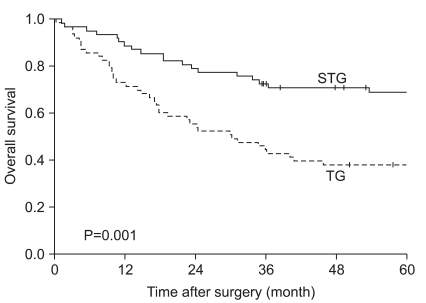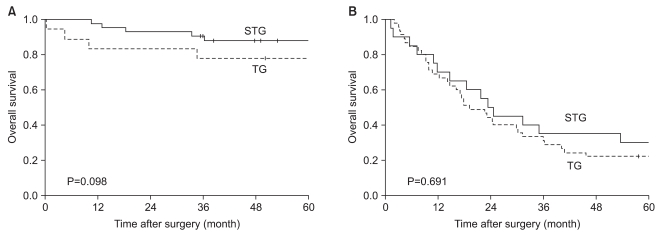J Gastric Cancer.
2010 Dec;10(4):226-233.
Which Is the Optimal Extent of Resection in Middle Third Gastric Cancer between Total Gastrectomy and Subtotal Gastrectomy?
- Affiliations
-
- 1Department of Surgery, School of Medicine, Ewha Womans University, Seoul, Korea. kimyi@ewha.ac.kr
Abstract
- PURPOSE
In resectable gastric cancer, choice regarding the extent of resection depends on tumor size, location, and distance from resection margin. However, there remains controversy for choice of resection for tumors in the middle third of the stomach. This study investigated patients who underwent gastrectomy in order to analyze the differences between total gastrectomy (TG) and subtotal gastrectomy (STG).
MATERIALS AND METHODS
From 2000 to 2006, 125 patients with a tumor in the middle third of the stomach underwent radical gastric resection at EUMC. We retrospectively conducted comparative analysis for the differences in clinicopathological characteristics and prognosis between TG and STG.
RESULTS
The average tumor size was 6.7 cm for TG, and 4.1 cm for STG. The number of metastatic lymph nodes were 13.3 for TG, and 3.7 for STG. Patients with more advanced cancer were more likely to receive TG. The 5-year survival rate for TG was lower (38.1%) than STG (69.0%). However, if tumor stages were stratified, there was no significant difference in the survival rate. Histologically, for the undifferentiated type of cancer (Stage 1, 2), the 5-year survival rate of STG was higher (88.1%) than TG (75.0%).
CONCLUSIONS
Comparing patients with tumors in the middle third of the stomach who underwent TG and STG, there was no statistically significant difference in the 5-year survival rate. If stages were stratified, the clinicopathological characteristic becomes a key factor in deciding the prognosis, rather than the choice of resection. Thus if the radical resection margin can be obtained for a tumor in the middle third of the stomach, STG is considered instead of TG.
Keyword
MeSH Terms
Figure
Reference
-
1. Sim YK, Kim CY, Jeong YJ, Kim JH, Hwang Y, Yang DH. Changes of the clinicopathological characteristics and survival rates of gastric cancer with gastrectomy: 1990s vs early 2000s. J Korean Gastric Cancer Assoc. 2009; 9:200–206.
Article2. Kim W, Park CH, Park SM, Park WB, Lim KW, Kim SN. Prognostic significance of lymphatic and perineural invasions in patients with gastric cancer who have no lymph node and serosal involvement. J Korean Gastric Cancer Assoc. 2001; 1:77–82.
Article3. Accessed July 4, 2010. http://www.cancer.go.kr/cms/statics/mortality/index.html/.4. Billroth T. Offenes schreiben an Herrn Dr. L. Wittelshofer. Wien Med Wochenschr. 1881; 31:161–165.5. Dicken BJ, Bigam DL, Cass C, Mackey JR, Joy AA, Hamilton SM. Gastric adenocarcinoma: review and considerations for future directions. Ann Surg. 2005; 241:27–39. PMID: 15621988.6. Stein HJ, Sendler A, Siewert JR. Site-dependent resection techniques for gastric cancer. Surg Oncol Clin N Am. 2002; 11:405–414. PMID: 12424859.
Article7. Clark CJ, Thirlby RC, Picozzi V Jr, Schembre DB, Cummings FP, Lin E. Current problems in surgery: gastric cancer. Curr Probl Surg. 2006; 43:566–670. PMID: 17000267.
Article8. Bozzetti F, Bonfanti G, Bufalino R, Menotti V, Persano S, Andreola S, et al. Adequacy of margins of resection in gastrectomy for cancer. Ann Surg. 1982; 196:685–690. PMID: 7149820.
Article9. Jang YJ, Park MS, Kim JH, Park SS, Park SH, Kim SJ, et al. Advanced gastric cancer in the middle one-third of the stomach: Should surgeons perform total gastrectomy? J Surg Oncol. 2010; 101:451–456. PMID: 19924722.10. Sobin L, Gospodarowicz M, Wittekind C, editors. International Union Against Cancer (UICC). TNM Classifi cation of Malignant Tumors. 2009. 7th ed. New York: Weiley.11. Davies J, Johnston D, Sue-Ling H, Young S, May J, Griffith J, et al. Total or subtotal gastrectomy for gastric carcinoma? A study of quality of life. World J Surg. 1998; 22:1048–1055. PMID: 9747165.
Article12. Bozzetti F, Marubini E, Bonfanti G, Miceli R, Piano C, Crose N, et al. The Italian Gastrointestinal Tumor Study Group. Total versus subtotal gastrectomy: surgical morbidity and mortality rates in a multicenter Italian randomized trial. Ann Surg. 1997; 226:613–620. PMID: 9389395.13. Bozzetti F, Marubini E, Bonfanti G, Miceli R, Piano C, Gennari L. Italian Gastrointestinal Tumor Study Group. Subtotal versus total gastrectomy for gastric cancer: five-year survival rates in a multicenter randomized Italian trial. Ann Surg. 1999; 230:170–178. PMID: 10450730.14. Kim IH, Kim YC, Kim SM. Prognosis of total and proximal gastrectomy for gastric cancer. J Korean Surg Soc. 1986; 31:545–555.15. Lim HJ, Jeong YJ, Yang DH. A comparative study on the outcomes of total and proximal gastrectomies performed for gastric cancer. Korean J Gastroenterol. 2002; 40:364–370.16. Gouzi JL, Huguier M, Fagniez PL, Launois B, Flamant Y, Lacaine F, et al. Total versus subtotal gastrectomy for adenocarcinoma of the gastric antrum. A French prospective controlled study. Ann Surg. 1989; 209:162–166. PMID: 2644898.17. Braga M, Molinari M, Zuliani W, Foppa L, Gianotti L, Radaelli G, et al. Surgical treatment of gastric adenocarcinoma: impact on survival and quality of life. A prospective ten year study. Hepatogastroenterology. 1996; 43:187–193. PMID: 8682460.18. Oh CA, Kim DH, Oh SJ, Choi MG, Noh JH, Sohn TS, et al. Changes of the preoperative and postoperative nutritional statuses in patients with gastric cancer and assessment of the nutritional factors that are correlated with short-term postoperative complications. J Korean Gastric Cancer Assoc. 2010; 10:5–12.
Article19. Bozzetti F, Ravera E, Cozzaglio L, Dossena G, Agradi E, Bonfanti G, et al. Comparison of nutritional status after total or subtotal gastrectomy. Nutrition. 1990; 6:371–375. PMID: 2134560.20. Rohatgi PR, Yao JC, Hess K, Schnirer I, Rashid A, Mansfield PF, et al. Outcome of gastric cancer patients aft er successful gastrectomy: influence of the type of recurrence and histology on survival. Cancer. 2006; 107:2576–2580. PMID: 17075877.21. Gospodarowicz M, Benedet L, Hutter RV, Fleming I, Henson DE, Sobin LH. History and international developments in cancer staging. Cancer Prev Control. 1998; 2:262–268. PMID: 10470455.22. Sobin LH. TNM: principles, history, and relation to other prognostic factors. Cancer. 2001; 91(8 suppl):1589–1592. PMID: 11309755.23. Ha TK, Kim HJ, Kwon SJ. Does the new UICC/AJCC TNM staging system (7th Edition) improve assessing prognosis in gastric cancer compared to the old system (6th Edition)? J Korean Gastric Cancer Assoc. 2009; 9:159–166.
Article24. Deng J, Liang H, Sun D, Wang D, Pan Y. Suitability of 7th UICC N stage for predicting the overall survival of gastric cancer patients after curative resection in China. Ann Surg Oncol. 2010; 17:1259–1266. PMID: 20217252.
Article25. McNeer G, Bowden L, Booner RJ, McPeak CJ. Elective total gastrectomy for cancer of the stomach: end results. Ann Surg. 1974; 180:252–256. PMID: 4601986.
- Full Text Links
- Actions
-
Cited
- CITED
-
- Close
- Share
- Similar articles
-
- Quality of Life after Curative Surgery in Patients with Gastric Cancer: Comparison between a Subtotal Gastrectomy and a Total Gastrectomy
- Quality of Life of Long-term Survivors after a Subtotal or a Total Gastrectomy for Gastric Cancer
- The Preservation of Left Gastric Atery in Laparoscopy-Assisted Subtotal Gastrectomy with Splenectomy of Stomach Cancer
- Nutritional Status after Curative Surgery in Patients with Gastric Cancer: Comparison of Total Versus Subtotal Gastrectomy
- Plasma Ghrelin Level According to Extent of Gastric Resection



